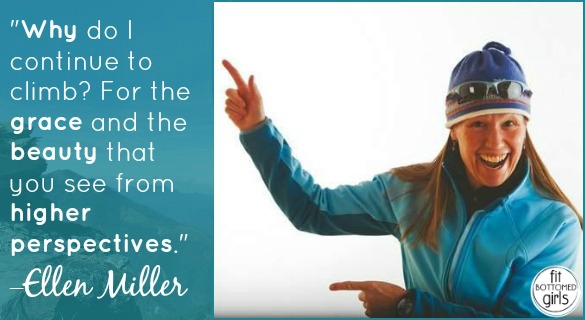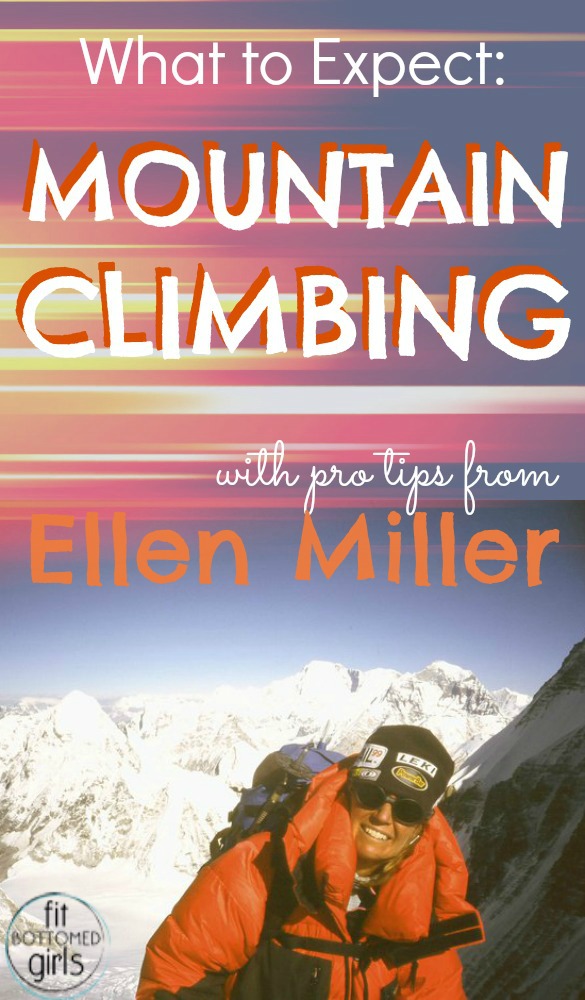Mountain Climbing: What Beginners Should Expect
Have you been reading all of Kate’s amazing hiking posts and getting inspired to find a challenging peak of your own to summit? Fantastic! Enthusiasm and determination are two tools you’ll need to achieve your goals, but to find out what else you’ll need to do (and what you should expect as you train and climb), I went to a true expert: Ellen Miller, the first American woman to complete the Everest trilogy (which includes Mount Everest itself, adjacent peak and fourth-highest mountain in the world Lhotse and Nuptse, which only about 30 people in the world have climbed).
She also happened to be my amazing guide as I hiked the Berry Picker Trail in Vail this summer. Probably not exactly comparable to climbing Mount Everest, but it’s worth noting because, aside from the fact that she’s a literal rock star (ha! get it?), she’s also an incredible person with a beautiful spirit, so I knew that talking to her about what to expect when climbing a mountain would provide us with far more than just a packing list and climbing tips.
What to Expect: Mountain Climbing
1. Plan for success and prepare accordingly — and remember, your first time doesn’t have to be a major expedition! “You don’t want a beginner signing up for a five-day mountain climbing trip, for example. A beginner is going to want to start on something like a Colorado Fourteener, for a one-day, long, high hike. They want something that’s within their grasp but will challenge them in an exciting and fun way. So, we’re looking for a positive, fun experience, and we want to be guided out of our comfort zones to a degree. But you don’t want to be scared out of your wits.
“Be pretty clear about what you’re getting yourself into, and then undertake a training program that’s going to facilitate the process of climbing that mountain. When people take the time to train properly, it just makes the experience that much more fun.”
2. You really can train anywhere. “Trail running is one of my favorite methods for building cardiovascular fitness because it does take a degree of cardiovascular fitness to climb mountains, and a degree of being comfortable on dirt and rock, so that’s why I emphasize trail running over road running, to become comfortable on uneven surfaces.
“Second, for any kind of climbing, I think the indoor climbing walls that are available in a lot of urban areas [are worth trying]. It doesn’t have to be a super steep or overhanging climbing wall, but just putting themselves in some situations on a climbing wall that they haven’t been in before.
“Also, tall office buildings! I have a gentleman right now who’s training for Nepal, and he’s taking his pack and hiking up tall office buildings in Chicago, because that’s all he has to work with — a StairMaster and a tall staircase, basically. Stadiums also offer great stair options for being outdoors and training with your daypack or backpack.”
3. You’ll be blown away by what you see. “People ask me often, ‘Why do you continue to climb?’ and I think that at the top of the list is, ‘For the grace and the beauty that you see from higher perspectives and vantage points. You get to see the earth and nature in a different way.'”
4. You won’t always reach the top. “Keep in mind that it’s not always about the summit. It’s about the process and your climbing partner and your experience and nature. You’re not going to get to the summit every single time. Even the very best mountain climbers in the world don’t! And that’s the beauty and the mystery of climbing, that’s what makes it so intriguing I think — you never really know.
“And leave room for the unexpected! Leave room for the fact that you might have to turn around because of the weather, leave room for understanding that something far beyond your control may happen on a mountain and you may not be able to go to the summit. I always tell people that I’ve learned much more on the mountains that I did not summit than the ones I did.”
5. It’s harder than you think. “Oftentimes, people will underestimate the strength and tenacity or endurance that it takes to climb mountains, and when they get there and a situation comes up, they’re like, ‘Whoa! This is a lot harder than I thought it was going to be!’ Breaking through that is a beautiful surprise for people. I think a lot of people don’t really understand some of the inherent dangers of climbing, like random rock falls or weather patterns — how capricious the weather can be in the high mountains, or avalanches and stuff. It’s not only about putting one foot in front of the other, but it’s also about taking into consideration a lot of factors in your environment.”
6. You’ll discover an inner strength you didn’t know you had. “When people are faced with a challenge that they weren’t sure they could overcome, that’s the biggest surprise … We learn so much about ourselves on a mountain — in a positive way. We learn what we’re made out of, and that’s really exciting for people to push through the challenging parts. And then they’re standing on a summit! It’s a very rewarding process.”
7. You’ll probably be the cause of some of your own discomfort. “[A common mistake is that] people haven’t broken in their footwear properly — they just haven’t walked around enough in their hiking boots, so I encourage people to really break in their footwear before they attempt a bigger mountain. Second of all, is not quite nailing the gear packing — not bringing the right pair of gloves, or the right type of GoreTex jacket, or the down coat. They forget their goggles or they forget their sun hat. I mean, gosh, these days you can get online and get lists for everything from day hikes and Colorado 14ers … You can Google ‘gear list for Mount Ranier’ and come up with 10 different, really well-written gear lists to use as a resource for what you should have in your pack!”
8. You’ll have the opportunity to choose your own adventure, but you’ll want to choose wisely. “Look for reputable operators and mountain guides. You want them to have great reputations for safety, and for hiking, and for summit success. Check out the credentials of your guiding company and make sure they are certified mountain guides. Ask for references. Reputable companies will give you clients to call and talk about what they’ve experienced on their trips. I would highly recommend talking to experienced people.”
9. When booking a mountain guide, know that the price point is directly related to the amount of work the operators and guides do for you, as well as the different amenities that are offered. “Let’s say you have a 65-year-old woman who wants to climb Kilamanjaro. She might not want to sleep on the ground in her tent. She may want a little cot or bed thing, and she may choose to pay extra for that, or she may choose to have a shower tent, whereas the younger people might not care about going five days without showering. It’s the little bells and whistles that people are going to pay more for, but it may make a difference in the way that they want to experience the mountain, and that’s fine. These days, especially with a mountain like Kilamanjaro, people can choose the style in which they want to climb. There are lots of options out there.”
Anybody else feeling inspired to book a trek? —Kristen



Comments
Hiking can teach us so much. I absolutely feel so much gratitude for this beautiful earth when I’m out in nature- and for my amazing body when I reach the top of a mountain (admittedly much smaller mountain than what you’re talking about here:).
Comments are closed.